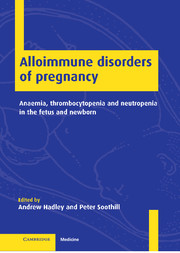 Alloimmune Disorders of Pregnancy
Alloimmune Disorders of Pregnancy Book contents
- Frontmatter
- Contents
- List of contributors
- Preface
- Foreword
- List of abbreviations
- 1 Pathophysiology of the alloimmune cytopenias
- 2 Blood group antibodies in haemolytic disease of the fetus and newborn
- 3 Basis and practice of screening for haemolytic disease of the fetus and newborn
- 4 Epidemiology and screening for alloimmune thrombocytopenia
- 5 Principles of antibody-mediated immune suppression and the prevention of maternal RhD alloimmunization
- 6 The clinical application of anti-D prophylaxis
- 7 Fetal genotyping
- 8 Laboratory assays to determine the severity of haemolytic disease of the fetus and newborn
- 9 Assessing the severity of haemolytic disease of the fetus and newborn: clinical aspects
- 10 Antenatal therapy for haemolytic disease of the fetus and newborn
- 11 Neonatal therapy for haemolytic disease of the newborn
- 12 The diagnosis of alloimmune thrombocytopenia
- 13 The immunological diagnosis of alloimmune neutropenia
- 14 Fetal and neonatal treatment of alloimmune thrombocytopenia
- Index
5 - Principles of antibody-mediated immune suppression and the prevention of maternal RhD alloimmunization
Published online by Cambridge University Press: 26 October 2009
- Frontmatter
- Contents
- List of contributors
- Preface
- Foreword
- List of abbreviations
- 1 Pathophysiology of the alloimmune cytopenias
- 2 Blood group antibodies in haemolytic disease of the fetus and newborn
- 3 Basis and practice of screening for haemolytic disease of the fetus and newborn
- 4 Epidemiology and screening for alloimmune thrombocytopenia
- 5 Principles of antibody-mediated immune suppression and the prevention of maternal RhD alloimmunization
- 6 The clinical application of anti-D prophylaxis
- 7 Fetal genotyping
- 8 Laboratory assays to determine the severity of haemolytic disease of the fetus and newborn
- 9 Assessing the severity of haemolytic disease of the fetus and newborn: clinical aspects
- 10 Antenatal therapy for haemolytic disease of the fetus and newborn
- 11 Neonatal therapy for haemolytic disease of the newborn
- 12 The diagnosis of alloimmune thrombocytopenia
- 13 The immunological diagnosis of alloimmune neutropenia
- 14 Fetal and neonatal treatment of alloimmune thrombocytopenia
- Index
Summary
The first evidence that passively administered antibody could suppress the immune response to the corresponding antigen was documented a century ago. Since then, the administration of anti-D to D-negative individuals has become firmly established as an effective measure to prevent alloimmunization to D. Anti-D prophylaxis is the most widespread clinical application of specific antibody-mediated immune suppression. This chapter first reviews the historical background and some of the early experimental and clinical studies on the prevention of RhD alloimmunization. The essential characteristics and possible theories to explain the mechanism of action of prophylactic anti-D are then discussed. Finally, progress made towards the introduction of monoclonal anti-D is reviewed.
Haemolytic disease of the fetus and newborn due to anti-D
About 50 years ago, there were at least 1000 neonatal deaths a year in England and Wales from HDFN, an incidence of approximately 150 per 100000 births. At a large hospital – Queen Charlotte's in London – between 1946 and 1949, the neonatal death rate was even higher, at 3.2 per 1000. Stillbirths represented an additional 30% of cases. In the early 1940s in Manitoba, Canada, 10% of perinatal deaths were due to HDFN and the death rate of affected babies was 40% Improved obstetric and neonatal care resulted in a 10-fold reduction in the number of deaths, first as a result of the introduction of neonatal exchange transfusion, then premature delivery and, finally, as a result of intrauterine transfusion, either intraperitoneally or, more recently, by ultrasound-guided delivery into the umbilical cord vessels.
- Type
- Chapter
- Information
- Alloimmune Disorders of PregnancyAnaemia, Thrombocytopenia and Neutropenia in the Fetus and Newborn, pp. 73 - 96Publisher: Cambridge University PressPrint publication year: 2001
